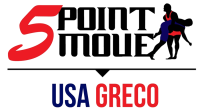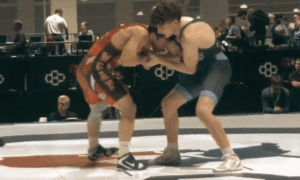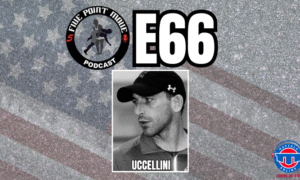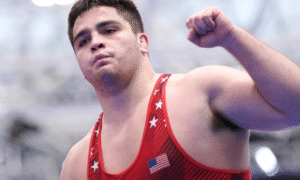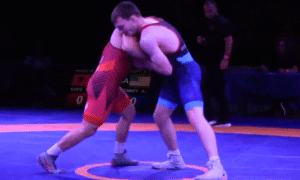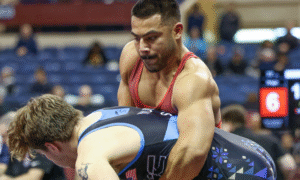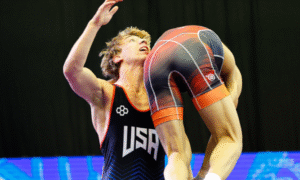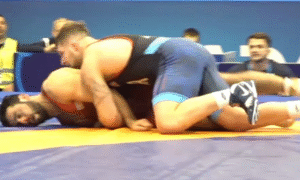Each fall in the US, there are approximately two million freshmen taking up space on college campuses. Many of the them are wide-eyed and hopeful, slinging around brand new backpacks filled with big textbooks and bigger ideas. Maybe a lot of these students will also get involved in various school-related activities, be it clubs, sports, fraternities, or some other such socializing time-passer. Round and round it goes, these rites of passage in the college lifestyle. There’s a lot to get to, after all. It all comes and goes quite fast and the problem with that is for most college students, their collective time on campus winds up being spent in anonymity.
However, a small percentage of the student body at Northern Michigan University in Marquette is anything but anonymous. That’s because since 1999, the school has represented the promised land for many of the most talented college-aged Greco Roman wrestlers in the country. Initially dubbed the United States Olympic Education Center (or USOEC for short) and now known as the Olympic Training Site (OTS), the wrestling program at Northern Michigan has produced a litany of accomplished athletes who have achieved success both nationally and internationally.
Counting this year, USOEC/OTS attendees have been responsible for 14 Junior National titles, five University World Championship medals (including two champions, Spenser Mango [2006] and Max Nowry [2012]), two Senior World medals (Justin “Harry” Lester [2006, 2007] and Andy Bisek [2014, 2015]), and nine Olympic appearances (including 2008 bronze medalist Andy Wheeler as well as Ben Provisor, Andy Bisek and Robby Smith this year). This isn’t even counting the vast number of wrestlers who have been a part of various Senior National teams over the past decade and a half. In other words, athletes who who have attended the Greco program at Northern Michigan University usually find the podium in one event or another, wherever and whenever they compete.
The Chance at a Different Path
Naturally, this isn’t a coincidental phenomenon. Greco Roman wrestling in the United States has long been seen as a “specialty sport”, a somewhat neglected sibling to the folkstyle and freestyle versions of wrestling that are popular this side of the Atlantic. Therefore, what Northern Michigan provides in essence could be seen as a necessity. That is, if the country wishes to remain competitive in the style on an international scale. With very few elite training centers focused on Greco Roman in the US, Northern Michigan acts as a bridge between development and the finished products who populate the sport’s homebase at the Olympic Training Center in Colorado Springs.
Former US Greco Roman National Team head coach Steve Fraser, who currently sits as the Chief of Donor and Alumni Relations for USA Wrestling, was a principle figure in the blooming of the Northern Michigan USOEC project. Originally put together with federal funding thanks to Michigan Congressman Bart Stupak (D), the program lived and breathed through the scholarships awarded to athletes. Named after Stupak’s deceased son, the BJ Stupak Scholarship took on the lion’s share of the costs associated with wrestlers (and other Olympic sport athletes) training on campus. For Greco Roman competitors, the entire situation was a dream come true. It was also groundbreaking for the style in the US.
“It is Greco’s only college-age program, allowing for Greco-focused athletes to get a college education and be trained by professional coaches,” Fraser declares. “”I used to say this was Greco’s secret weapon in the US.” To underscore Fraser’s point, just dial it back to 2007, when two USOEC wrestlers were on the Senior roster that won the Greco Roman World Championships, with Lester earning a clutch bronze medal. Skip ahead from there to the 2008 Olympic Trials, as both Mango and Betterman emerged to make the squad. On and on it went through the next few years, as the “developmental program” continued putting athletes on Senior National teams.

Betterman and Mango were among the USOEC’s earliest stars. (Photo: John Sachs)
Part of that is the coaching. 1996 Olympian Gordy Morgan was the first head coach in the program’s history and in its second full year helped lead the USOEC to the team title at the University National Championships. Morgan then passed the baton over to Ivan Ivanov, a former Bulgarian national champion and Olympian himself. Ivanov’s influence saw the program reach a whole new level, for it was under his tutelage that saw greats like Joe Betterman, Mango, Jake Fisher, and Lester reach national prominence. And this is just a mere sampling; the overall list of championship-caliber wrestlers under Ivanov reads almost like a phone book. If you ask the former coach, Northern Michigan exacts an advantage that is strikingly obvious at every age-group competition.
“If wrestlers realize they want to take Greco on as a priority style for them, but then go to college and come back (to it), they are going to find it is very difficult to compete against athletes coming from Northern Michigan,” Ivanov says.
At the end of the day, it always comes down to the opportunity itself.
Prior to 1999, the typical trajectory for a wrestler who wished to take on Greco as a career choice involved competing in college folkstyle for four years before finding a decent number of training partners and coaches who were supportive of their goals. Very rarely had there been a Dennis Hall-type (1995 World Champion, three-time Olympian and also, head coach at NMU 2009-2010) who entered into full-time Greco Roman competition ahead of completing their college schooling.
The traditional collegiate route, at least when compared to how wrestlers overseas train in the international styles, is at best archaic and at worst, counterproductive. That makes what the OTS at Northern Michigan delivers the perfect antidote: An opportunity for a college education while training to become an Olympic champion. It’s rather academic: Even if beginning Greco training full-time at 18 isn’t that much of a head start when lined up against opponents from Russia and Hungary, it is still better than getting going at 22 or 23 years old. At least that’s how multiple-time World Team member Joe Betterman, who was one of the training center’s early stars, feels about it.
“I wanted to get straight to business and train for the Olympics right away instead of wrestling in the NCAA’s for four years and then begin my Olympic journey,” Betterman says. “I wanted to get ahead of the curve and get great at Greco Roman wrestling for the Olympics. To give myself the best chance to make a World and Olympic team.” And it worked. Along with Lester, Fisher, and Mango, Betterman played a substantial role in helping the program gain some mainstream recognition.
No Points for Exposure
The country’s seeming insistence on promoting folkstyle and freestyle has a “give some, take some” kind of feel. On one hand, it is the national governing body’s (USA Wrestling) responsibility to provide wrestling coverage and opportunities the populous demands. Needless to say, the majority of wrestlers and parents have a deeper interest in free and folkstyle. On the other, those same circumstances don’t exactly translate into an exorbitant amount of room for something like the Northern Michigan program to gain more traction within the greater wrestling community.
“I didn’t even know about Northern Michigan when I decided the make the move,” says Joe Uccellini, NMU class of 2005 and whose club, Curby 3-Style Wrestling, is named after Jacob Curby, a talented former USOEC competitor who tragically passed away in 2010. “If I had known, I would have went right after high school, I would have been there.” A somewhat reasonable counterpoint could be that wrestling coverage, specifically via the internet, was certainly not as available 14 years ago as it is nowadays. Even still, a lack of exposure is still perceived by many involved in the sport. Current NMU wrestler and 2016 Junior and University World Team member Dalton Roberts doesn’t think Uccellini’s experience is all that isolated despite the difference in eras.
“There are a lot of kids out there where this is what they would like to do,” explains Roberts. “They’d like to wrestle Greco all year ’round and travel overseas to follow that Olympic dream but frankly, don’t know that it’s an option.” Roberts, 20, is part of the “internet generation” and has been wrestling since childhood. The fact that he sees an issue is a fairly decent indication there might be one. “To be honest, it is kind of scary, because to think that someone has those kinds of dreams and goals and doesn’t know this option is out there is huge missed potential not only for the USOC and the Olympic dream, but for the wrestling community as well.”
Uccellini agrees. “There was never any advertising. It makes it feel like it’s invite-only, not that you should actually apply there.” All one really needs to look at is the bevy of recent high school wrestlers who have committed to Division I colleges. When someone signs on to wrestle at one of the nation’s powerhouse folkstyle programs like Penn State or Iowa, that news is celebrated on most wrestling media outlets. But a kid deciding to go to Northern to tackle Greco full-time? Not so much. Is it because the general wrestling audience doesn’t care about Greco Roman wrestling? Or is it because as a whole, we haven’t given them the information they need regarding some of Greco’s collegiate-aged stars?

Athletes from the NMU-OTS program attend a camp at the Olympic Training Center in Colorado Springs in 2015. (Photo: Matt Lindland)
The national governing body, caught between appeasing the folkstyle-hungry membership base while also promoting Olympic wrestling, has really picked up steam when it comes to the overall advertisement of Greco Roman’s more well-known US athletes, particularly in the lead-up to the Rio Games. So that isn’t the whole issue, at least not in and of itself. However, it does bring up a question: Since Northern Michigan is intended to be the primary pipeline that feeds the Senior-level, why isn’t it put center-stage by the NGB and other outlets the same way college folkstyle programs are?
Some have pointed to the 2008 Olympic Trials as sort of a rallying cry. Mango had risen to the top of the 55 kg field while Betterman locked down the 60 kg title. But in what could have and should have been a banner moment for the Northern Michigan program as a whole, the achievement, in Betterman’s eyes, wasn’t capitalized on enough. “There should have been exposure when Spenser and I made the Olympic Team,” says Betterman. “It should have been, ‘Look, we’re grabbing these kids out of high school and they are becoming Olympic and World-level athletes right away.'” Whatever you want to point to, whether fairly or unfairly, there is a feeling among NMU wrestlers that they are forgotten about by USA Wrestling and the industry as a whole. These athletes want attention not only to highlight their own successes, but also to attract more recruits to the cause. Former National Team member and current Naval Academy assistant coach Nate Engel (NMU class of 2010) believes it is partially a cultural issue which stands in the way of Northern being a billboard directing the way towards an Olympic Greco future.
“My theory is that we’re a freestyle-centric country,” Engel says. “Freestyle is pushed, pushed, pushed, but I think if we grew Greco at the high school and middle school levels, and younger, and also taught more coaches how to be Greco coaches, Northern Michigan would grow tremendously.”
A brunt of the general confusion also lies with the fact that at the present time, Northern Michigan is funded in concert by both the NGB and Northern Michigan itself, as Stupak’s scholarship dollars are no longer available. Thus, the sentiment USA Wrestling could do more to advertise one of its own programs but doesn’t is what has alumni concerned, especially considering that NMU wrestlers have been extremely successful of late.
2010 graduate and current head coach for William Baptist College in Arkansas, Kerry Regner, sees it two ways. To Regner, the program has not received the attention he feels is warranted. At the same time, he’s also not convinced it is a single-pronged problem.
“It’s hard for me to find results on how the current team is doing,” Regner says. “I usually have to do some digging on results pages. That saddens me because I know there are some good things going on.” However, he doesn’t feel this is all on the NGB. In a digital climate, individual institutions do have the ability to reach out to users on their own. “I understand USA Wrestling does cover the OTS, but they also have to write things that pique an interest. And to be fair, I also don’t see very much publicity coming from the OTS itself via social media. I hope to see improvements from both sides in the future.” Fair enough. Social media is a powerful recruiting tool and one that would be better-served to be used more often. Northern Michigan does pump out its own reports and stories pertaining to its athletes and competitions, but from a social media marketing context there is a lot of room for growth, certainly.
If a lack of coverage is to be considered the main sticking point facing NMU, then the flipside to that is what consistent exposure might bring to the program. Because think of it for a second: Greco Roman wrestling in the US has precisely one official developmental training center. It already boasts of a storied history and what’s more, has proven time and again to be a dominant force when matched up against other domestic competition. It might even appear to be an institution that has sustained and grown in spite of what has been at times, underwhelming exposure. So what would happen if a beaming ray of light shone down on it for all of the country to see? Would it entice more high school students with Greco experience to consider it a viable path to follow? Would it help the US once again break through as an international power? Unsurprisingly, the athletes and coaches we talked to believe all of that and more.
Feeding the Feeder
If the ultimate goal of Greco Roman wrestling at Northern Michigan is to churn out combat-ready competitors at the international level, then right next to it would be keeping the pond stocked with talent. Call them “Objectives 1 and 1a.” Naturally, the cries for an increased amount of press coverage pertaining to the program are most often aimed directly at the latter objective. Joe Uccellini, who happened onto campus as a 22-year old with an Associate’s degree already in his pocket, learned about Northern from his club coaches while the USOEC was still in its infancy. So when combining the program’s relative youth at that time with the lack of media outlets around 14 years ago, a situation like that isn’t an eye-opener. What is, however, is that the former competitor still has to hold up signs pointing to it for the wrestlers he now coaches.
“You can advertise the past wrestlers’ successes, but you can also advertise that there are opportunities to apply,” asserts Uccellini. “It’s got to be tangible. That’s one big thing. It might not feel tangible to wrestlers. My wrestlers know because I went there, but most have probably never heard of it.” The ongoing debate brings this all to a wishful state for those affiliated with NMU past and present, begging the question, What if? What if increased exposure led to even higher recruitment levels? What if the US is losing out on potential Olympic medal contenders because too many potential recruits are still unaware there is a glimmering paved road that can lead to the attainment of the ultimate dream?

Past USOEC athletes include 10 World Team members, four World medals, an Olympic medal, a four-time Iditarod champion, over a dozen coaches, and plenty of successful career professionals. (Photo: Joe Uccellini)
The way Engel sees it, the very notoriety associated with winning on the World stage would be a deciding factor for any recruits who may be on the fence as to what their best options are. “It would get kids interested in the program earlier on and put the idea in their heads, Hey, I can do this, I can be a World champ, I can be an Olympic champ. They know it’s a possibility because they have a place where they can achieve those goals while also getting a college education.”
Engel brings up a great point. What Northern Michigan promises as much as a fast-track to meaningful Greco Roman training is also the one item which usually becomes a priority for incoming freshmen and their parents — accessibility. Not only does NMU provide room for 18 scholarship athletes, but non-scholarship wrestlers pay tuition at an in-state rate, saving thousands of dollars. From a wrestling standpoint, it might be all about the top-flight training and instruction. Of course. The thing is, with tuition costs constantly rising in conjunction with the incessantly politicized nature of traditional college wrestling programs, it’s easy to see how and why Northern should be such an easy sell. Parents and students can save big on an education while also getting a front-row seat to what the original mission for wrestling in this country is all about.

Engel was one of the USOEC’s lightweight anchors during the Ivanov era. (Photo: John Sachs)
Lasting Impressions
Plenty of long-told, if not tired and redundant clichés about wrestling have been passed down from one generation to the next. The whole character-building and perseverance thing, clawing back from adversity, all of it is drummed into everyone’s heads before they’ve even learned a headlock. It is pandering, wrestling-style. And it is always “Wrestling teaches…” Wrestling teaches sacrifice, wrestling teaches hard work… With certainty, these are absolute truths. Through wrestling, one does learn hard work, sacrifice, and dedication. But it isn’t wrestling by itself that is responsible for any of these ideals. The sport doesn’t exist in a vacuum. No, these attributes come from programs and coaches, teammates and experiences. And when you’re lucky enough, there are enough of these traits already present inside of an athlete so that when he does enter into a program, the rest will take care of itself.
Take Andy Bisek, for example. Bisek (NMU class of 2010), one of the top Greco Roman competitors in the world, was a walk-on at Northern Michigan. You hear it all the time about the native Minnesotan (“7th at Fargo!”). Once Ivanov and then-assistant coach Jim Gruenwald recognized Bisek’s unrivaled work ethic and ability teeming beneath the surface, it was then and only then Bisek was offered a scholarship. It’s a tale worth telling because this is the case of an athlete whose desire to attend NMU led to a career which has seen remarkable progress. It all started in Marquette.
“Chas Betts (NMU class of 2010) is the one who told me about Bisek,” remembers Ivanov. “Chas said, ‘Andy hasn’t placed top-three yet, but he was an All-American. He doesn’t care if he’s on scholarship or not, but he wants to come to Northern Michigan and he’ll pay his own way.'” Bisek had to fight from the moment he arrived. As a “facilities use” student, victory came in the form of incremental improvement. Before too long, the effort began paying off. “We actually had two or three guys who were better than Andy at that time,” continues Ivanov. “Eventually, he was able to take over and win competitions at 74 kilos.” Now that Bisek is a two-time World medalist with a legitimate shot at reaching the medal stand next weekend in Rio, Ivanov can’t help but see the synergy between the OTS’s early value and Bisek’s success. “Andy is one of the greatest examples of a product from Northern Michigan and the Olympic Training Center, as well. That’s why he has been able to accomplish getting medals from the World Championships.”

Two-time World medalist and 2016 Olympian Andy Bisek blossomed once he began attending the Northern Michigan-USOEC program. (Photo: John Sachs)
It does come back around to letting people know who may otherwise be unaware about both Northern’s legacy and effectiveness. This is how it is even for Ivanov, who hasn’t been involved at the school in almost eight years. “As a coach, I would like to see these facts presented more often to promote the program. It will help to spread the word that NMU is very effective, and to athletes who are considering Greco to not wait until after college to go and try to compete with these guys, because they are already three or four years ahead of everyone else.”
The life lessons most glean from wrestling almost appear as if they supercharge the NMU alumni. For some wrestlers, their experiences at the university led them to become successful, sought-after coaches. Others saw their competitive stock rise to previously-unforeseen heights. There have been plenty of cases like Betterman, who wound up becoming the top 60 kilogram competitor in the country for the better part of a decade but originally touched down in Marquette as a young, raw upstart with more guts than credentials. But he surrendered to the environment and after a couple of years, started defeating established national-caliber competitors. What difference did all of this make in Betterman’s life and career? It’s probably unquantifiable.
“Honestly and truly, I would not be the athlete I am today, and I wouldn’t have been as successful as I was without that program,” confirms Betterman. “Northern created a foundation for my career. You need a strong foundation to become an Olympic-level athlete. Without it, my career would have plateaued.”
For Regner, NMU didn’t just bring out the confident and capable athlete inside of him during his competitive days. It also encouraged him to understand the nuances associated with the overall wrestling experience, helping make Regner one of the most respected young coaches in the sport today. “My decision to go to the USOEC has given me the opportunity to do what so little get to do, which is to give back to the sport on a full-time basis as a profession. My coaches over those years, Ivan, Jim, Dennis and Willie (Madison) not only showed me how to train athletes, but also how to treat them. They helped me mold my moral compass, my faith and my work ethic. No other place in the world could have prepared me better than the USOEC did.”
Still Going Strong, Growing Even Stronger
There are six wrestlers who attended Northern Michigan currently represented on the US National Greco Roman team (Olympic weights). One of whom, Alejandro Sancho (66 kg) is still on the NMU roster. This past June, there were 13 finalists from the NMU-OTS team at the University Nationals/World Team Trials with five champions. There are also three NMU wrestlers on this year’s Junior World Team (Randon Miranda, 50 kg; Dalton Roberts, 55 kg; and Jamal DeArmond, 66 kg). This is all in one year. Should you decide to trace the program’s accolades back further, especially at the University age-group, you’ll just get lost in the numbers.
Northern Michigan-Olympic Training Site head coach Rob Hermann, who has been involved in all facets of Greco Roman coaching in the US over the course of his career (which includes leading the 1996 US Olympic Team in Atlanta), believes that the success of the program is the result of the interest athletes have coming along with the team environment that is created.
“The biggest thing is that it has to be your passion,” Hermann says. There is probably no issue there, as wrestlers from the US who wind up choosing Greco are often the passionate sort. So when these devoted athletes from all over the country unite together as a collective, which is how it works at Northern Michigan, they can’t help but drastically improve due to one another’s presence. Hermann is very confident that’s precisely why NMU continues to stand out. “We’ve got 45-50 guys training full-time Greco while being full-time students. They feed off each other. Iron sharpens iron. You might not start at the top, but we’re all here for the same reason, and that’s to make World and Olympic teams. Everyone makes everyone else better. We don’t keep any secrets.”
Another highlight to Hermann’s tenure that has brought a lot of positive attention to the school is the dawning of the “Superior International Camp.” The objective of the camp, which is held inside of NMU’s Superior Dome, is to give wrestlers from the US and other countries a week-long opportunity to hone their skills under the watchful eyes of highly-respected instructors while also getting a feel for legitimate international competition. Open to both Juniors and Cadets, the camp’s first year drew 70 attendees — not bad. The 2016 edition, its third running, clobbered that number with a staggering 115 athletes. In just three short years, the endeavor has caught on like some kind of Greco Roman wildfire.
“We had to turn people away, and I hate to do that,” Hermann confides. “It’s important that we get these kids wrestling with the best competition in their age group. If we don’t do that, then we’re never going to get them ready in a timely manner.” People have for sure taken notice. Athletes, parents, and other coaches have already expressed interest for next year’s Superior Camp, telling Hermann they are going to be bringing more wrestlers with them. Even a vaunted Greco program from Minnesota sent some representatives to Marquette to check it out.
“Minnesota Storm came up for the Superior Camp and they brought five of their Seniors. Before they left, they said they learned more from that camp then they had all year. It’s not just for the Northern people, it’s for anyone else who wants to come up here.”
The Continuation
The stories of the Mango’s, Betterman’s, Wheeler’s, Lester’s and Bisek’s of the world are super, but they weren’t written in vain. What Morgan was there for in the beginning and Ivanov turned into a dynasty has never been forgotten. How could it be? The legend of the Northern Michigan program has been kept alive in the form of coaches and competitors who threw every ounce of themselves into it. What happens in Marquette leaves a mark. And although that is something for all involved to be proud of, there are other chapters still being published. That actually might be the most important part of it all.
Just take a look at the present results. Three Junior World Team members and four more on the University squad. They aren’t just spot-fillers, either. Each Northern Michigan athlete is considered a serious medal contender at both World Championships. That kind of thing doesn’t happen on its own. It sure doesn’t occur in local clubs and good luck combing through National Team rosters without past and present NMU grapplers sprinkled in throughout. It is an initiative that was born out of the desire to supplement the country’s depth and has turned into a proving ground that has experienced incredible achievement at each level it has been showcased on. The goal hasn’t changed since 1999, and neither has the overall product. What Hermann likes most is that Northern cultivates talent at such a consistent rate, regardless of an athlete’s prior credentials, any questions regarding its validity can be answered by what you see on the mat.
“Watching these guys grow into World Team members, they had to work at it. Take Alex Sancho. He didn’t win a match in Fargo and three years later he’s the number two guy in the country, making the Junior World Team, made the University World team, made the National Team, and could have very easily made the Olympic team, too.” Now, this is where you might need a refresher. The original intention of Northern is to serve as a launching point for eventual Senior competition. “We are a developmental program,” reminds Hermann. “Our room is set up for 2020 and I expect four or five guys who are in our room now to be on that Olympic Team.”
One thing we know, is that it’s not mere pie-in-the-sky talk. The past lights the path the present walks on. People are learning. They are going to learn even more. The tradition of Greco Roman wrestling in America changed the moment the USOEC offered another avenue to explore. It shouldn’t be whispered or glossed over. It isn’t hearsay. If evidence demands the scrutiny of a jury, by all means, convene. Whatever you come up with is likely immaterial — the verdict is already in. Greco at Northern Michigan is the lifeline to a future that can no longer be ignored.
